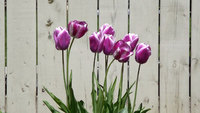Adding structure to your garden

It’s cold and definitely not sunny so you probably aren’t spending much time in your garden at the moment! However, this time of year is perfect for you to take stock of your outside space and plan improvements. Use the Winter to complete your planning and the Spring to do the hard work. By the time the summer arrives you will be able to enjoy your new and improved garden and not waste any of the good weather.
Planning
Don’t dive right into the fun bit which is buying pretty plants and planters. You probably need to create some structure first. Think about the things you use your garden for or you want to use if for. You might realise that you need to create new areas, section off areas, lay paving, create raised beds establish paths or a play area. You need to plan where these structural elements are going to go first and how you are going to construct them. Then you can think about making them pretty with plants and pots.
Planters and Raised Beds
If your garden is flat you should consider creating some levels. Not only will this add more interest to your garden but it makes for much easier weeding and planting. In addition, if your soil is very poor, raised areas allow you to add better soil meaning you can plant flowers and vegetables that otherwise wouldn’t grow.
You can buy large planters but they are expensive and difficult to transport. An easy alternative is create these levels and planters from timber. You can simply buy tongue and groove boards and a few sturdy posts and off you go. These same materials can be used to build gates, screens, sheds and retaining walls.
Sectioning & Screens
It can often make sense to section off areas of your garden. If you only have a front garden then some screening can be added to give you privacy. In larger gardens screening can be used to create shaded areas, hide sheds or play areas and provide wind protection for seating areas and vegetable gardens.
Some plants make good screens – evergreen hedges are great for providing privacy. Where you need added security, fencing can be erected. Wire fencing is effective but unsightly however this is a good option if you can plant a screening hedge in-front of it. Wooden fence panels are great. They can be left natural or painted/stained to fit into any design scheme and style. Wooden or metal trellising can also be used to create screens and they can be covered in climbing plants effectively increasing your planting space. You can also consider creating a living hedge from willow which is a very cheap and creative solution.
Seating Areas
Even the smallest gardens usually have room for a seating area. Do you have one? If not create one. If you do have one already does it work well or are things you need to change?
When will you use the seating area – morning, afternoon or evening? Make sure the space you choose for your seating area receives the sun when you will use it. You may need to cut back or remove trees or bushes to maximise the sunlight you can enjoy. The Winter is a great time to do this because the plants are dormant and will not be damaged by cutting back. Because there are no leaves on the trees and shrubs it is easier for you to see what you are doing too.
Flooring is also important. If your garden is wet you will need a clean surface so you don’t get muddy feet. A simple and cheap solution is to level the ground and then cover it with weed retardant matting. Secure the matting edge with stones or railway sleepers and then cover it with a layer of gravel. This will keep the area underfoot clean, dry and it will also provide a good surface for chairs, tables and BBQs. If you have more money to spend you splash out on some flag stones or paving.
Reuse
If you have to clear away existing garden structures and plants in order to create new areas don’t throw away the old material or plants. You can often reuse them.
Old wooden beams and sleepers can be used to edge paths, hold down weed retardant matting, create raised beds or form benches. Paving stones can be moved and reused to create paths.
Plants can be dug up and moved. Winter is the idea time to do this for most plants because they are dormant. Dig the plant up with as a big a root bowl as you can and then simply move it to another location. Even trees can be moved in this way if you give them a hard cut back first. Note that you will need to give transplanted plants more attention the year after they are moved – they need time for their roots to recover so you will need to give them more water than usual.

